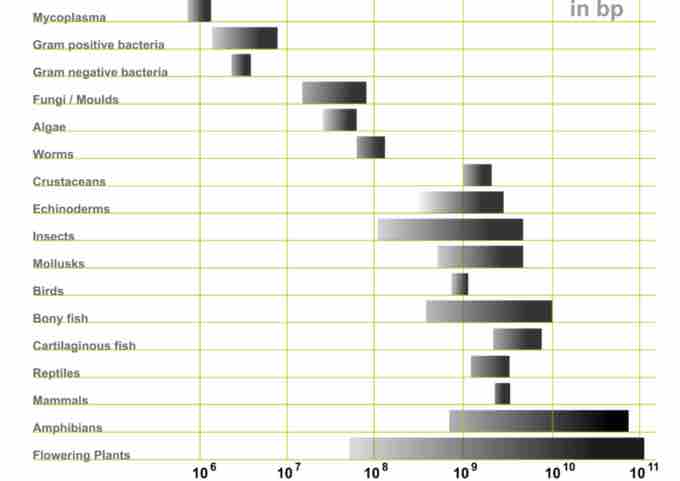Bacterial genomes are generally smaller and less variant in size between species when compared with genomes of animals and single cell eukaryotes. Bacterial genomes can range in size anywhere from 139 kbp to 13,000 kbp. Recent advances in sequencing technology led to the discovery of a high correlation between the number of genes and the genome size of bacteria, suggesting that bacteria have relatively small amounts of junk DNA.
Studies have since shown that a large number of bacterial species have undergone genomic degradation resulting in a decrease in genome size from their ancestral state. Over the years, researchers have proposed several theories to explain the general trend of bacterial genome decay and the relatively small size of bacterial genomes. Compelling evidence indicates that the apparent degradation of bacterial genomes is owed to a deletional bias.
In prokaryotes, most of the genome (85-90%) is non-repetitive DNA, which means coding DNA mainly forms it, while non-coding regions only take a small part. Most biological entities that are more complex than a virus sometimes or always carry additional genetic material besides that which resides in their chromosomes. In some contexts, such as sequencing the genome of a pathogenic microbe, "genome" is meant to include information stored on this auxiliary material, which is carried in plasmids. In such circumstances then, "genome" describes all of the genes and information on non-coding DNA that have the potential to be present.
Amongst species of bacteria, there is relatively little variation in genome size when compared with the genome sizes of other major groups of life. Genome size is of little relevance when considering the number of functional genes in eukaryotic species. In bacteria however, the strong correlation between the number of genes and the genome size makes the size of bacterial genomes an interesting topic for research and discussion. The general trends of bacterial evolution indicate that bacteria started as free-living organisms. Evolutionary paths led some bacteria to become pathogens and symbionts.

Graph of variation in estimated genome sizes in base pairs.
Unlike eukaryotes, bacteria show a strong correlation between genome size and number of functional genes in a genome.
The lifestyles of bacteria play an integral role in their respective genome sizes. Free-living bacteria have the largest genomes out of the three types of bacteria; however, they have fewer pseudogenes than bacteria that have recently acquired pathogenicity. Facultative and recently evolved pathogenic bacteria exhibit a smaller genome size than free-living bacteria, yet they have more pseudogenes than any other form of bacteria. Obligate bacterial symbionts or pathogens have the smallest genomes and the fewest number of pseudogenes of the three groups. The relationship between life-styles of bacteria and genome size raises questions as to the mechanisms of bacterial genome evolution.
Researchers have developed several theories to explain the patterns of genome size evolution amongst bacteria. One theory predicts that bacteria have smaller genomes due to a selective pressure on genome size to ensure faster replication. The theory is based upon the logical premise that smaller bacterial genomes will take less time to replicate. Subsequently, smaller genomes will be selected preferentially due to enhanced fitness.
Deletional bias selection is but one process involved in evolution. Two other major processes (mutation and genetic drift) can be used to explain the genome sizes of various types of bacteria.
Evidence of a deletional bias is present in the respective genome sizes of free-living bacteria, facultative and recently derived parasites and obligate parasites and symbionts. Free-living bacteria tend to have large population sizes and are subject to more opportunity for gene transfer. As such, selection can effectively operate on free-living bacteria to remove deleterious sequences resulting in a relatively small number of pseudogenes. Continually, further selective pressure is evident as free-living bacteria must produce all gene-products independent of a host. Given that there is sufficient opportunity for gene transfer to occur and there are selective pressures against even slightly deleterious deletions, it is intuitive that free-living bacteria should have the largest bacterial genomes of all bacteria types. Recently formed parasites undergo severe bottlenecks and can rely on host environments to provide gene products. As such, in recently formed and facultative parasites, there is an accumulation of pseudogenes and transposable elements due to a lack of selective pressure against deletions. The population bottlenecks reduce gene transfer and as such, deletional bias ensures the reduction of genome size in parasitic bacteria.